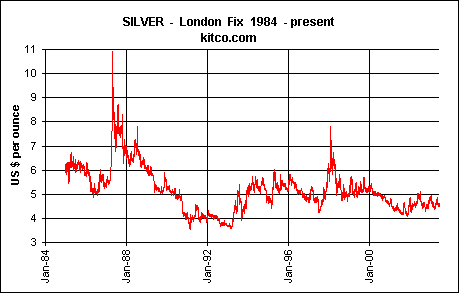Why Update an Appraisal?
The answer is simple:
Prices of gems and precious metals can drop!
It is widely believed that jewelry is a good investment. Most people expect that jewelry will at least hold its value, and will probably appreciate. A diamond is forever, they think. And what else, after all, is good as gold? They hold antique jewelry in high esteem. They see jewelry as enduring, beyond the ravages of time.
Let's look at some economic facts that affect jewelry consumers and insurers.
Gems
The jewelry industry, like any other, is affected by supply and demand. If for some reason gem material of a certain quality is in short supply, the price will go up. If a popular cut goes out of favor, or if the market is flooded with a particular gem, its price will go down.
For example, from 2003 to 2004, a 3-carat oval diamond (of good color and clarity) dropped in price from $11,500 to $11,000 wholesale. A one-carat princess cut diamond dropped from $4,500 to $4,300 in the same period.
In that same report in early 2004, diamond dealers said that 1.5-carat round cuts were in tight supply, diamonds larger than 5 carats were difficult to find, 3-carat emerald cut diamonds were doing well, etc. Professional jewelers use this information to determine what they can buy and to adjust their retail prices.
Thus, an appraisal's valuation for diamond jewelry is not just an estimation of value for "diamond," but for this particular cut, color, clarity, size and shape of diamond at this particular time.
For colored stones, the price fluctuations are even more dramatic. Consider the recent history of tanzanite. After a large find, the price was low. Then the main mine flooded, so the price jumped. After 9/11, it was rumored that tanzanite sales were funding Al Qaeda, so the price fell. Then supply shortages again drove the price up. In early 2003, tanzanite rough was selling for $300 a gram (or 5 carats); by June 2004, it was going for $700 a gram. Consumers who purchase during such a shortage will be paying top dollar, but the jewelry may be worth considerably less a year later.
Precious Metals
Prices of precious metals can also fluctuate.
The following chart (from kitco.com) illustrates the volatility of gold prices from March 1975 to March 2004.

The following chart (from kitco.com) illustrates the volatility of silver prices from March 1984 to March 2004.

Antique Jewelry
Policyholders may be attached to antique jewelry that has been in the family for generations, or they may even buy old pieces, perhaps at auctions. Do not assume that jewelry is valuable because it is old. It often happens that jewelry that has been in the family for years was not expensive to begin with, but price information was lost.
Jewelry is also subject to fashion. A style or setting that was once popular may no longer be considered attractive or desirable. An old stone may not be as well cut as modern methods make possible. A setting of multiple stones may include some gems along with some imitations — a common practice. Even the shape of a stone can go out of fashion.
An appraisal valuation is based on the current selling price of the jewelry. If the jewelry could not be sold today, its value may be little more than the gems and scrap metal.
Synthetics & Treatments
Oddly enough, the existence of synthetic (manufactured) gems can affect the price of natural (mined) gems. For example, the Chatham-created emerald, being a lab-made gem, can sell at a stable price. Since this is a top quality synthetic emerald, it has had the effect of holding down the price of natural emeralds. High-quality synthetic diamonds now coming onto the market are expected to have a similar effect on the price of natural diamonds.
Innovations in treating gems can affect the market for untreated gems. Recent technology allows irradiating poor quality drab-colored topaz to a bright blue. The irradiated blue stones are so attractive that the price for natural blue topaz plummeted (while the price of topaz in other colors remained stable).
FOR AGENTS & UNDERWRITERS
Since jewelry's value can be affected by so many time-related factors — fashion, weather, politics, supply and demand, industry competition, technology, synthetics — it is wise to have a new appraisal and valuation for scheduled jewelry every 3 to 5 years. A current valuation insures that the policyholder pays appropriate premiums and the carrier will not overpay on a claim.
Urge policyholders to submit a jewelry appraisal on ACORD 78/79, prepared by a Certified Insurance Appraiser™ (CIA). Such an appraisal gives a complete description of the jewelry. The CIA jeweler is a graduate gemologist, experienced in selling jewelry, and aware of trends and fluctuations within the industry, who is also trained in appraising for insurance.
If an appraisal other than ACORD 78/79 is submitted, score it for completeness using ACORD 18, Jewelry Appraisal and Claim Evaluation. If essential information is missing, you can use the form as a basis for discussing with policyholders the importance of having a complete descriptive appraisal. Consider doing insurance-to-value (ITV) calculations each time an appraisal is updated.
FOR ADJUSTERS
When settling claims on scheduled jewelry, it's best to be working with an appraisal and valuation made within the last five years. If the appraisal is older, consult with a jewelry insurance expert, working on your behalf, to determine whether valuation accurately reflects the current market.
Next Issue:
Why Update an Appraisal? Part 2
Inherent vice, breakdown of treatments, and other factors may result in lowering jewelry's value over time.
©2000-2025, JCRS Inland Marine Solutions, Inc. All Rights Reserved. www.jcrs.com

